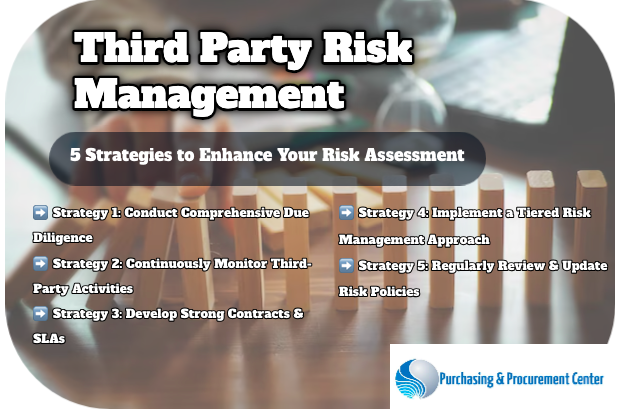Third Party Risk Management: 5 Strategies to Enhance Your Risk Assessment
Third Party Risk Management Summary:
1. Basics of Third Party Risk Management
2. Steps to Prepare for a Supplier Risk Assessment
3. Strategy 1 – Conduct Comprehensive Due Diligence
4. Strategy 2 – Continuously Monitor Third-Party Activities
5. Strategy 3 – Develop Strong Contracts and SLAs
6. Strategy 4 – Implement a Tiered Risk Management Approach
7. Strategy 5 – Regularly Review and Update Risk Policies
8. 3 Additional Considerations to Have in Third Party Risk Management

Third party risk management addresses risks which can expose your organization to security breaches, financial instability, compliance gaps, and reputational damage.
This makes them a critical function that helps identify, assess, mitigate, and monitor significant pitfalls.
In this guide, we discuss 5 strategies to enhance your risk assessment using Third Party Risk Management (TPRM).
You Might Also Like: Supplier Risk Assessment Process: Detailed Step-by-Step Breakdown
Basics of Third Party Risk Management
Third Party Risk Management involves identifying, analyzing, and mitigating risks brought on by outsourcing services to third-party vendors or suppliers.
This can include everything from IT services to janitorial functions. Essentially, any external collaboration that impacts your company's operations can pose potential risks.
Key risks include cybersecurity threats, data breaches, legal liabilities, and even reputational damage that can arise from the actions or mishaps of a third party. The stakes are high, and so is the complexity, given the myriad of evolving threats in business ecosystems.
Read More: COST REDUCTION IN PURCHASING & PROCUREMENT!
Strategy 1 – Conduct Comprehensive Due Diligence
Exercise rigorous scrutiny before shaking hands. It involves evaluating potential third parties against various criteria, such as their financial stability, business resilience, reputation, and security practices.
A comprehensive due diligence process provides a clear view of the risks posed by a third party and sets the stage for informed decision-making.
- Financial Assessment: Evaluate the vendor's financial health to ensure they can deliver on their commitments through thick and thin.
- Security Vetting: Delve into their cybersecurity infrastructure, policies, and incident response history.
- Business Continuity Capabilities: Insist on understanding their contingency plans for business disruptions.
Strategy 2 – Continuously Monitor Third-Party Activities
Due diligence is not a one-off event. The digital terrain is ever-changing, and so are the associated risks. Ongoing scrutiny of third-party vendors helps identify emerging threats.
This vital strategy encompasses consistently keeping an eye on the third party’s adherence to compliance standards, reviewing performance metrics, and ensuring continuous adherence to data protection regulations.
Your comprehensive monitoring strategy should involve:
- Regular Audits: Schedule consistent audits to check for compliance with contractual agreements and industry regulations.
- Benchmarking Performances: Track performance against pre-established benchmarks and SLAs to spot discrepancies early.
- Active Cybersecurity Surveillance: Continuously watch for potential cybersecurity red flags within the vendor’s infrastructure.
Strategy 3 – Develop Strong Contracts and SLAs
Your contracts and Service Level Agreements (SLAs) are your armor in the legal battlefield. Clear, detailed contracts and SLAs offer a powerful way to manage third-party risk.
These should articulate expectations, responsibilities, and consequences for noncompliance.
Craft contracts that:
- Outline Performance Metrics: Clearly define service delivery expectations with precise, measurable metrics.
- Include Compliance Clauses: Ensure all required compliance mandates are integrated into the agreement.
- Detail Response Protocols: Include action plans for incidents like data breaches to ensure prompt and proper response.
Strategy 4 – Implement a Tiered Risk Management Approach
Not all vendors pose equal risk, and your third party risk management resources shouldn’t be spread thinly across all vendors.
Deploy a tiered approach – categorize vendors based on the criticality and risk they pose to your organization.
Allocate your risk management resources proportionally, focusing more on those that are integral to your operations or have access to sensitive data.
This tiered strategy allows for:
- Effective Resource Allocation: By directing efforts to where they are most needed, you optimize resource use.
- Tailored Risk Mitigation: Customize your risk management practices for different types of vendor relationships.
- Focused Monitoring: Intensify scrutiny on high-risk vendors while maintaining an appropriate stance on lower-risk relationships.
Strategy 5 – Regularly Review and Update Risk Policies
Given the dynamic nature of risks, your third party risk management policies cannot afford to be static. A key strategy for staying ahead is to regularly review and revisit your risk management frameworks, policies, and procedures.
This ensures they remain effective and applicable to the evolving external and internal landscapes.
Routine reviews should:
- Incorporate Feedback and Insights: Leverage lessons learned from past incidents to strengthen security posture.
- Adapt to Regulatory Changes: Update policies to reflect the latest regulatory requirements and industry best practices.
- Engage Stakeholders: Involve various organizational departments to offer a comprehensive view on risk management.
Tip: Setting a regular review schedule also ensures that your strategies are aligned with the current risk landscape. Whether it’s quarterly, bi-annually, or annually, these reviews are crucial checkpoints in a robust risk management framework
3 Additional Considerations to Have in Third Party Risk Management
In addition to the strategies above, here are 3 additional third party risk management considerations you should have to enhance your risk assessment:
Consideration #1- Industry Regulations:
Be mindful of industry-specific regulations that may impact your third-party relationships. For example, healthcare organizations must comply with HIPAA (Health Insurance Portability and Accountability Act) when working with third-party vendors handling patient data.
Consideration #2- Cyber Insurance:
Consider cyber insurance to provide financial protection in the event of a cyberattack or data breach involving a third party.
Consideration #3- Third-Party Risk Management Tools:
Explore specialized TPRM software solutions to streamline your risk assessment and monitoring processes.
By taking a comprehensive and proactive approach to third-party risk management, you can build a secure and resilient foundation for your business success.
Third Party Risk Management is an Ongoing Process!
By implementing these 5 key strategies, you can significantly enhance your third party risk management process.
A robust third party risk management program fosters trust and transparency with your vendors, strengthens your security posture, and safeguards your organization's reputation.
Don’t forget that third party risk management is an ongoing process. By continuously monitoring your vendor relationships, adapting your approach, and fostering a culture of risk awareness, you can confidently navigate the complexities of today's interconnected business environment.
Boost Your Expertise

Looking to boost your expertise in supplier risk assessment and enhance your value within your organization? Explore our in-depth CIPP and CIPM certification programs now!
These certifications are designed to deepen your understanding of procurement processes and elevate your standing in Supplier Risk Assessment.
If you're part of a larger team, consider our Supplier Risk Management Training for groups of 10 or more. This training is tailored to strengthen your team's resilience, especially during uncertain times.
Get Back From Third Party Risk Management to Supplier Risk Management


